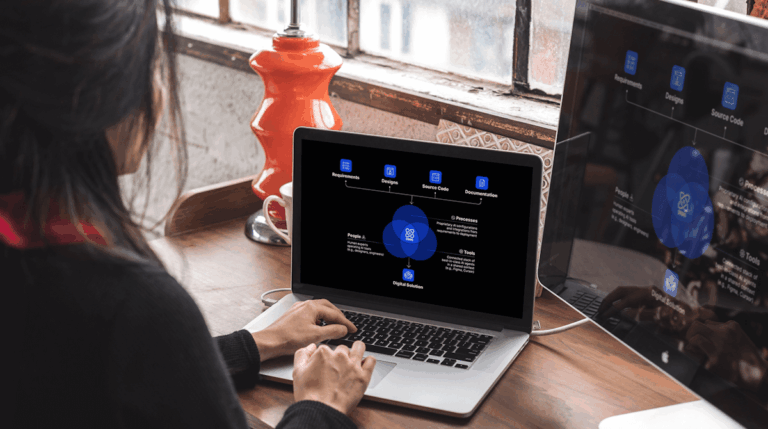In today’s digital world, technological evolution is crucial to staying competitive. However, migrating outdated applications can be a daunting challenge: how can you ensure a smooth transition while protecting the user experience and data? At Dualboot Partners, we have perfected a progressive migration approach that minimizes risks, optimizes timelines, and maximizes results: the Strangler Fig Pattern.
The Problem: A Full Migration Can Be an Unnecessary Risk
A traditional “big bang” migration —where the old system is shut down to launch the new version— carries multiple risks:
- Service Downtime: Halting operations can frustrate users and impact productivity.
- Data Loss: Without a robust plan, active sessions and stored data can be lost.
- Abrupt Changes: A complete redesign of the interface may lead to user rejection, even if the new system is technically superior.
- Pause in New Features: During the migration process, the development of new features or critical bug fixes often stops, slowing down the product’s progress.
- High Costs: A sudden migration can require a significant budget due to investments in infrastructure, additional staff, and unforeseen expenses if issues arise.
Instead of taking a leap into the unknown, we offer an evolutionary process that replaces parts of the system gradually and progressively, enabling continuous improvements and minimizing negative impacts.
Migration Challenges and Our Approach
Migrating an application isn’t just about replacing old code. It involves overcoming several technical and operational challenges:
- Downtime Risk: We use load balancers to manage the flow of users between both versions.
- Data Loss: We implement shared storage configurations to maintain unified sessions and data.
- Compatibility Issues: Regression testing is performed in staging environments identical to production.
- User Confusion: Gradual releases (canary releases) are used to introduce new features progressively.
- Pixel Perfect Expectations: We prioritize visual consistency without demanding exact pixel replication. This avoids bottlenecks and enables faster progress.
- Complex Rollbacks: We implement an automatic rollback plan that allows the system to revert to the previous version quickly in case of critical issues.
- Pause in New Features: In a traditional migration, new feature development often halts until the process is completed. To avoid this, we propose:
- New Pages and Modules: If the new feature involves adding complete pages or modules, they are implemented directly in the new application version.
- Major Changes to Existing Pages: If a page requires significant modifications, we evaluate whether it is more efficient to prioritize migrating that page to the new application before making the change.
- Dedicated Support Team: We maintain a team assigned to address bugs in the legacy system, ensuring that the migration process continues smoothly while critical incidents are resolved.
Our Solution: The Strangler Fig Pattern
Inspired by the strangler fig tree, which grows around another tree until it completely replaces it, the Strangler Fig pattern allows you to modernize your application without interruptions.
How It Works:
- Modular Implementation: New modules gradually replace the old ones without disrupting overall operations.
- Controlled Traffic Redirection: Load balancers, such as Nginx or AWS ALB, are used to control the percentage of users interacting with the new components.
- Canary Releases: New functionality is released to a subset of users to monitor performance before a full rollout.
- Shared State Management: User sessions remain active thanks to shared cookies and local storage synchronization.
- Automatic Rollback Plan: If an issue arises, the load balancer can quickly redirect users back to the previous version without affecting their experience.
Real-World Success: Case Studies Using the Strangler Fig Patter
Case 1: Enabling Growth and Stability in a High-Impact Learning Platform
A leading learning management platform for professional sports organizations faced a major challenge: rapid growth had led to unstable performance, outages, and customer dissatisfaction. A potential acquisition was at risk due to the outdated state of their technology.
By applying the Strangler Fig pattern, we executed a progressive migration, transitioning from an aging architecture to a modern, scalable solution. One of the key upgrades was the migration from AngularJS to Angular 18, which allowed us to enhance performance, improve maintainability, and introduce modern development practices.
Key Achievements:
- Seamless Migration: We rebuilt the platform’s architecture while keeping the system fully operational.
- Zero Downtime: Load balancers manage user traffic between old and new versions.
- Enhanced Performance: The migration dramatically improved platform stability, reducing customer complaints.
- Successful Acquisition: The technological upgrade was a key factor in securing the acquisition, ensuring a smooth transition to the new parent company’s internal development team.
Case 2: A Phased Approach for a Large-Scale Real Estate Investment Firm.
A major real estate investment firm faced a different challenge: their technology stack was outdated, but due to the size and complexity of their system, a full migration would have taken over a year before seeing any results.
By adopting our progressive migration approach, they were able to modernize their system in modular phases, ensuring that each update was deployed in manageable increments without disrupting business operations. A crucial part of this modernization was the transition from AngularJS to Angular 18, which brought improved performance, better developer experience, and long-term support.
Key Achievements:
- Incremental Modernization: Instead of waiting for the entire migration to be completed, we migrated individual modules from AngularJS to Angular 18, ensuring a continuous improvement cycle.
- Reduced Business Disruption: By phasing out the old system gradually, their operations remained uninterrupted throughout the migration process.
- Knowledge Transfer to Internal Teams: Our team worked alongside their developers, equipping them with the necessary expertise to work with Angular 18 and continue the modernization process independently.
- Scalability & Performance Gains: With each new Angular 18 module, they experienced immediate performance improvements, better maintainability, and a more scalable architecture.
This approach ensured faster time-to-value and lower risk, allowing the company to stay ahead in a competitive market.
Leveraging Migration for Strategic Improvements
A migration is an excellent opportunity to optimize key areas:
- Endpoint Refactoring: Modernizing backend logic to improve efficiency.
- Security Enhancements: Updating authentication standards and data protection protocols.
- Implementation of Modern APIs: Integration of REST or GraphQL to enhance data exchange with the frontend.
Key Tools For Implementing the Strangler Fig Pattern
To ensure a safe and efficient migration, we use:
- Load Balancers: Tools like Nginx help manage traffic without disrupting operations.
- Staging Environments: These replicate the production environment to allow thorough testing.
- Automated Testing: We use regression testing tools that ensure consistency without requiring pixel-perfect precision.
Benefits of Our Solution
- Reduced Failure Risk: Errors are detected in a controlled manner before impacting all users.
- Gradual Updates: Users experience changes progressively, improving adoption rates.
- Seamless Visual Consistency: We avoid the hassle of replicating every detail, focusing instead on maintaining a harmonious appearance.
- Resource Optimization: By coordinating frontend improvements with backend optimization, we achieve a more efficient and scalable system.
- Cost-Efficient Migration: Our progressive approach spreads the migration investment over time, avoiding a single large upfront cost. Additionally, by migrating incrementally and maintaining a dedicated team for support, we reduce downtime, minimize rework, and prevent costly errors.
Contingency Plan: What We Do If Something Goes Wrong
If a critical issue arises, we follow an immediate action plan:
- Redirect to the Previous System: The load balancer is reconfigured to revert to the stable version.
- Root Cause Analysis: We log and analyze the issue to determine its origin.
- Implementation of the Fix: The fix is validated in the staging environment before redeployment.
Conclusion: Evolve Your Application Step by Step
Modernizing your application doesn’t have to be a stressful process. With our progressive migration solution based on the Strangler Fig pattern, we help you take your application to the next level without compromising your users’ experience or your team’s productivity.
Are you ready to take the first step towards a more modern and secure system?






